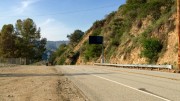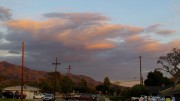The California Department of Conservation announced Nov. 6 a finalized regulatory map covering the complex Sierra Madre Fault Zone, which affects a portion of Glendora.
Part of the Sierra Madre Fault Zone, the Duarte Fault to be precise, runs underneath the Haugh Performing Arts Center of Citrus College.
The revised Sierra Madre Fault Zone Map, along with another map focusing on an active fault in West Hollywood, were initially issued in January of 2014 for preliminary analysis and public input to include geological and seismic data.
The revisions to most of the Sierra Madre Fault Zone Map occurred in the Rosedale development in Azusa where a portion of a fault zone was completely removed from the finalized map.
The Sierra Madre Fault Zone, roughly 46 miles long, consists of complex, branching faults identified in five segments. It last erupted about 10,000 years ago and could produce an earthquake of magnitude 6 to 7.
The regulatory maps, authorized under the Alquist-Priolo Act passed in 1972, are created to aid in land-use decisions in the greater Los Angeles area by identifying active earthquake faults and surrounding fault zones to developers to prevent the construction of habitable structures on the trace of these faults.
Structures built for human occupancy must be set back a minimum of 50 feet from the trace of the fault. While building on a fault is prohibited, the fault zones do not prohibit development, but rather prompt a site-specific investigation, said Don Drysdale with the Public Affairs Office at the California Department of Conservation.
“You have to hire a firm that’ll check to make sure there isn’t an active fault under where you want to build. Once you do that, you present the results to the local planning department and it’s incumbent upon them to tell them yea or nay,” Drysdale said.
It is unclear what, if anything, Citrus College plans to do to address the potential hazard the Duarte Fault presents to the 40-year-old Haugh Performing Arts Center.
Paula Green, Citrus College spokeswoman, released a statement to the Los Angeles Times:
“As a public educational agency, Citrus College obtains all necessary approvals from the California Geological Survey and the Division of the State Architect prior to engaging in any significant construction project. Citrus College continues to ensure that it is compliant with all DSA building and safety standards,” Green said.
Citrus College undergoes annual training with the National Incident Management System and the Standard Emergency Management System training curriculum, coordinated in part by the California Office of Emergency Services.
Certain courses in the NIMS SEMS curriculum are required to be completed by those who are deemed as emergency responders, said an employee of the Citrus College Facilities and Management department who did not wish to be identified.
The 40-year-old Performing Arts Building is composed of poured in place concrete, reinforced with steel girders.
“It was substantially built. It’s gone through a couple of temblors,” the Citrus source said, but if the Duarte Fault did produce an earthquake of a 6 or 7 magnitude, he was unclear how well the building would fare.
Properties yet to be developed require a geological analysis to locate a possibly fault.
“The cities and counties play a pivotal role. They are the ones that have to enforce the maps and make sure that developers have the correct studies done.” said Tim McCrink, Alquist-Priolo program manager. “They are required to have developers hire consultants to do the investigations to make sure people aren’t building on a fault.”
The AP Act specifies addressing surface fault ruptures as opposed to other forms of earthquake damage due to the ability for reverse faults to cause damage over a wider area, said Kate Hutton, seismologist with Caltech.
“Because a reverse fault is at an angle with the surface, more surface area is close to the fault than it would be for a vertical strike-slip fault, Hutton said to Glendora City News.
The finalized fault map has not changed land-use approaches in Glendora, said City Manager Chris Jeffers. He added that the concern for earthquake damage significantly rises as structures become taller.
A three-story apartment complex is under construction at the northeast corner of Glendora Avenue and Route 66 with the 280-unit Avalon Bay project, which features some three-story buildings.
“The building codes are so stringent that they already take in those types of considerations. There really isn’t the concern there … as there is for the much taller, multi, multi-story buildings,” Jeffers said.
“We can’t predict when these faults are going to rupture, all we can say is there is a high probability that we will feel strong shaking within the next 30 years,” McCrink said. “The best approach is to just ask people to be prepared.”
An online version of the map can be viewed by clicking this link.
For a PDF version, click this link.









Be the first to comment on "Calif. Finalizes Sierra Madre Fault Zone Map"